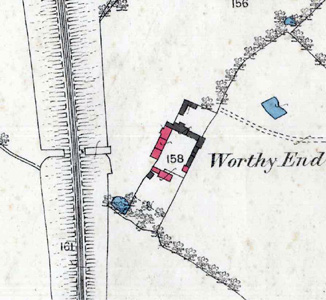
Worthy End Farmhouse on a map of 1882
Worthy End Farmhouse was listed by the former Department of Environment in July 1975 as Grade II, of special interest. The department dated the property to the 17th century, though it has later additions.
The building is timber-framed with a pebbledash render. The roof is made of clay tiles. The property is a long rectangular block in three sections and mostly comprises two storeys and attics with part of the structure being just a single storey. A lean-to addition stands at the rear.
Worthy End may mean "people of the enclosure's end". The name is first recorded, as Wrthing, in 1240. Today the farmhouse lies close to the Bedford to London railway line just south of the town of Flitwick. The early history of the farm is difficult to work out without a set of deeds as none have been deposited with Bedfordshire and Luton Archives and Records Service.
There are two possible histories for the farm. One sees it owned by the Wrest Park Estate. In 1663 when a property at Worthend alias Worthing in which John Pearles dwelt was conveyed, along with nine acres of land, by Edward Pearles of Redbourn, yeoman, John Pearles' brother, to Edward Pennifather of Eversholt, yeoman for £232 [L5/528]. Pennyfather bought other pieces of nearby land at various times and in 1673 he bought a house in Worthend "in which William Stevens dwells" abutting south on a lane, along with eighteen acres of land for £206 from Thomas Neale [L5/534].
In 1698 Pennyfather conveyed all his land in Greenfield, Flitton and Pulloxhill to his son John for £40 and an annuity of £15 per annum for life [L5/537]. IIn 1745 Pennyfather sold his house in Worthy End along with sixty two acres, one rood of land in Flitton and Greenfield to Charles Fletcher, Rector of Clophill, for £1,140 [L5/547-548]. The property is described as having a close of pasture of three acres adjoining and abutting south on a cottage and orchard of Isaac Coote. The next piece of land listed, New Close, contained two acres and abutted south on the road from Greenfield to Westoning. This evidence suggests that the messuage may have been Worthy End Farmhouse.
Fletcher made his will in 1753 [L5/551] and left his farm in Flitton and Greenfield to his daughter Margaret and Martha, the latter married to Nathaniel Pimlot. In 1789 Martha's daughters Anne Jackson and Frances Pimlot conveyed Worthy End Farm, now in the occupation of John Palmer, to Leonard Hampson of Luton in trust for sale [L5/555-556]. The farm was acquired by Philip, Earl of Hardwicke, husband of Jemima, Marchioness Grey, later that year for £1,209/7/6 and was added to the Wrest Park Estate. There is no record of the later sale of the farm which is odd, since following the death of her brother Nan Ino, 10th Baroness Lucas of Crudwell broke up and sold the estate between 1918 and 1920, some pieces by auction others to their tenants.
In September 1827 an auction sale was held at the George in Woburn of the estate of Sir John Everitt, deceased, Lord of the Manor of Weston Tregoz and Westoning [ST464]. Lot 2 was "a valuable inclosed freehold farm called Worth End in the parish of Flitton". The farmhouse comprised a parlour, a kitchen, four bedrooms, a brewhouse and dairy. Farm buildings consisted of two thrashing barns, stables, pigsties, a cow house and shelter hovel, a granary and "other requisite buildings". The farm comprised one hundred and twenty acres and was in the occupation of Edmund Sear who paid rent of £200 per annum. This is the other possible history of the farm - as part of the Manor of Weston Tregoz until this sale. It is possible that relatively soon after buying the farm the Wrest Park Estate sold it again to Sir John Everitt. However, none of the field names or descriptions in the sale catalogue match those in the conveyance of 1789. Nor does the farmhouse description in 1827 match that of 1926 [see below].
By 1926 we are on firmer ground. The Rating and Valuation Act 1925 specified that every building and piece of land in the country was to be assessed to determine its rateable value. The valuer visiting Worthy End Farm [DV1/H38/36] found it was owned and occupied by W. Britten. It had contained 114 acres before the Great War but by the visit date, 5th October 1926, contained 117 acres. The valuer commented: "Saw Mr. Britten said farm was outlying. Land very wet and heavy. Mr. Britten does not live in House"
The farmhouse comprised two reception rooms, a kitchen and a cellar with two bedrooms above. Water came from a pump. There was a W. C. but no electric lighting. The valuer noted: "Now Foreman in it".
The farm buildings comprised the following:
- West Block A: a brick and tiled stable for three; a cow house for five and a brick, wood and tiled old barn;
- North Block B: a brick, wood and tiled barn with a cement floor; a four bay open shed and two army huts used for storage;
- East Block C: a brick, wood and slated two bay cart shed; a store barn; four pigsties and a brick, wood and tiled granary.